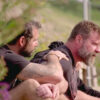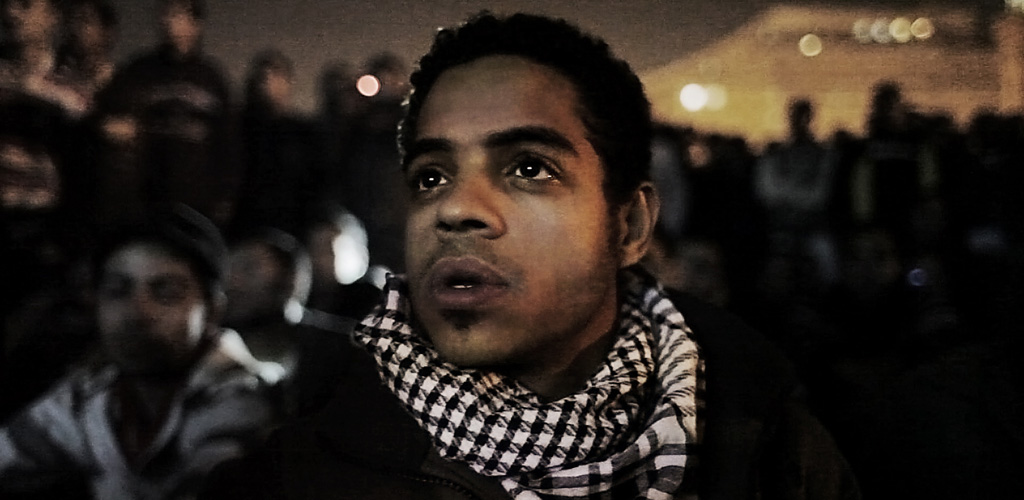To move forward with her latest film, Jehane Noujaim had to destroy one of her other ones. Literally.
Only moments after the “Control Room” director had arrived in Egypt, she found herself being interrogated for eight hours by the local authorities. Friends had told her not to bring her traditional camera for filming, as it would be confiscated on sight. (Instead, she snuck by a Canon DSLR, which looks more like a point-and-shoot still camera.) However, she had left in her bag DVDs of her 2007 film “Egypt: We’re Watching You,” the first time the documentarian ventured back to the country of her birth to make a film about a trio of women that formed the Web site Shayfeen.com to promote a legitimate alternative to the supposedly democratic presidential election proposed by then-President Hosni Mubarak, who suppressed protests through brute force.

“That’s a tiny piece of what people felt when they took to the square when they decided that they would not allow fear to control their lives,” she continued. “That unleashed this incredible energy where you’re standing next to somebody putting their life on the line for something that’s bigger than themselves. There’s an electric energy to that.”
Such electricity surges right off the screen in “The Square,” a film that threatened to rip the balcony right off the Bloor Theater when it made its official premiere there last month at the Toronto Film Festival due to the approving stomping of feet. Greeted by thunderous standing ovations wherever it goes, the relentless, breathtaking account of the Egyptian revolution from the perspective of six activists – Khalid Abdalla, Magdy Ashour, Ahmed Hassan, Ragia Omran, Ramy Essam and Aida El Kashef – whose stand with thousands of others in Tahrir Square ultimately brought about the end of Mubarak’s 30-year dictatorship has picked up audience awards both up north and earlier this year at Sundance before it was even finished.
With the help of a dedicated crew, Noujaim oversaw three years of filming in the rapidly changing region, not content to end with the election of Mohamed Morsi as president as the film did when it played in Park City. (Nor were the Egyptian people who ousted the Muslim Brotherhood-backed leader in July.) Now, after pulling together a variety of different video formats and storylines into one compelling whole, Noujaim finally took a breather to talk about why it was so important for her to be in Egypt for the protests, the continuing influence of D.A. Pennebaker and Chris Hegedus, and the unsung hero of the revolution who enabled filmmakers of all types to capture incredible overhead shots of Tahrir Square.

Sort of. I had made a film in 2007 called “Egypt: We’re Watching You” where things were rumbling then and I followed three women who were documenting all of the corruption that was going on around the elections. That film came out on BBC, but of course the country did not explode the way that it did in 2011. The protests mostly ended up with most everyone being arrested, beaten up and taken to prison. So when the rumblings were happening again in Egypt, I was filled with a cautious feeling and a bit of fear that the same thing was going to happen.
But Tunisia had exploded and I think a lot of Egyptians had watched what had happened there and wondered why this is not happening in Egypt. Also, there was the story of Khaled Saeed, who was killed by the police in Egypt and a Web site was created for him that millions of people signed onto. So when the rumblings were happening, I called the women that were in my previous film and they said, “Things are definitely happening and you should be there on 25th.”
I was torn because I was invited to Davos where all of the leadership of Egypt were invited, so I thought this might be a more interesting place to be because there will be cameras everywhere at the protest and there won’t be cameras with the leadership. So I took a flight to Davos [on] the 25th, the day the protests started, none of the Egyptian leadership showed up, so I tried to then get back [to Egypt] as soon as I could.
I just knew that I needed to be filming this. I wasn’t sure where the film was going to go from there. After Mubarak stepped down, it was a huge climax and how do you begin a film with the climax? But I knew that what was happening on the ground was a very important story to capture and I soon met all the characters in the film and I met the rest of my crew in [Tahrir] Square. This is what was very unique about the creation of this film was that it was a very collaborative process. All of the people that made the film, that shot the film all came together as filmmakers and protesters, trying to tell the story of this incredible event that was happening in front of us.
As you mention, so many people in the Square were capturing their own footage in order to provide information instantly. Did that redefine what you wanted to do as a filmmaker?
I don’t think that providing instant information took away from the fact that we were also making a longer form film, which has its own value in a very different way and I’m not sure that people completely understood at the time. I didn’t even understand exactly at the time what the story would be at the time. But there was an incredible generosity and an organic fluidity of how the footage was dealt with because everything that we were filming could be used and was given away at any moment if it was some kind of evidence or something that should be shared because it could change something on the ground. There was no keeping footage aside because we didn’t want it to come out for another three years. At the same time, all of us on the film knew we were working towards this longer narrative that would hopefully give people a context.
[This experience] hasn’t changed what I want to do because I made my first film [“Startup.com”] with the incredible filmmakers D.A. Pennebaker and Chris Hegedus and when I would take a break from editing, I would look at their old films shot in the ‘50s, ‘60s and ‘70s… ‘80s, 90s (laughs) — they really have done American history through the movie camera. What’s incredible about watching their films is unlike a book that you read or an interview film that you see, you’re really plunked right into the middle of whatever the action is and allowed to experience it for yourself. That is irreplaceable. That you cannot recreate. So what I hope to do with this film is follow characters on an emotional journey so that you really understand what it meant to be there on the ground and when people get a glimpse of that, hopefully, that will trigger them to want to read the thousands of books that are coming out about what’s happened over the last few years in the Arab world.

I really see it as two parts. You shoot and you try to capture everything that you can that is going to take you to the most important moments in revolution, so that people can really grasp what’s happening, but even more importantly than that, you’re trying to be there at every crucial moment of the characters that you’re following. You see the square filled with people that Mubarak’s taken down, but you don’t see what leads up to that. What does somebody have to go through to get a million people down to a square? You never see the times when Martin Luther King and Gandhi lost everything, their friends have left them and they think they’re a complete failure. And we asked that of our characters.
So it was a very interesting process for me watching this taking over of this piece of land and what people were doing with that. And that’s a very universal concept. It really is about the zeitgeist and that’s what I look for in making films — finding a very personal story that is going to give an inside window into the times we’re living in. Squares are being taken over in Greece and Brazil and there’s Occupy Wall Street, so it was something which I felt was a very universal movement that is happening and it was important to get a very personal view of that.
Still, I have to ask one question about the broader view — how did you get those amazing overhead shots of Tahrir Square during the revolution?
We have to give deep thanks and kudos to an incredible unsung hero of the revolution, Pierre Sioufi, who owns the building that overlooks the square. He probably would not have been able to do this if he didn’t own the building. Maybe he would have, but he would’ve been raided a lot sooner. When the revolution started happening, people in the square used it as a safe haven. They used his balcony as the place to hang the big sheet that gave all of the demands. And he gave access to the large foreign news crews who had their cameras on the square, which offered a protection to the revolutionaries because any kind of killing of the revolutionaries in the square would be automatically broadcast to the world. He allowed us to go up at times and film what was happening from that overhead shot.
The other person who should be getting credit for the beautiful tilt-shift lens and some of the most beautiful shots of the square is Muhammad Humdy, our director of photography, though each one of us has played a very important role in this film. Ahmed, our character shot about 25 percent of the film. Humdy, our DP, taught him how to use the camera — instead of running to the front lines with a rock, he’d be running to the front lines with a camera.

There’s no way we’d be where we are today without Sundance. It gave us an incredible boost of confidence. The entire team had been operating on fumes and unpaid for two years and when we got the Audience Award, it showed the team and the people in Cairo and the characters on the ground that people internationally cared about the story and the story wasn’t just about Egyptian politics, but it was reaching people on a human level.
That was amazing, though when we won and then went back into the editing and continued shooting, there were some people that thought we were completely bananas. But we knew the story was not finished and if this was going to be a historical document that people would be watching for years to come, it was very important to film this next stage of the revolution, which was basically the betrayal of the Muslim Brotherhood and the Muslim Brotherhood using religion to do exactly the same thing as the previous dictatorship had done.
Perhaps the most exciting screenings have been in high schools and colleges where kids have come up and said, “I don’t know anything about Egypt and to be honest, I don’t follow the news. But to me, this film is about people who care so deeply about [the issues they face], they felt so alive and it made me want to get involved and care about the issues that I’m passionate about in the same way.” That was really exciting for us to hear.
“The Square” opens on October 25th in New York at Film Forum. It will open in Los Angeles at the Sundance Cinemas Sunset 5, the Pasadena Playhouse 7 and the Monica 4 on November 1st.





Comments 2